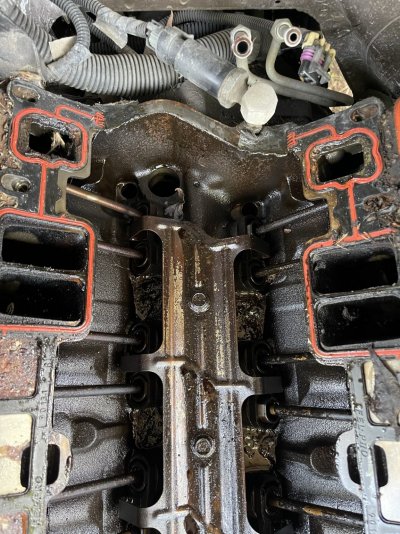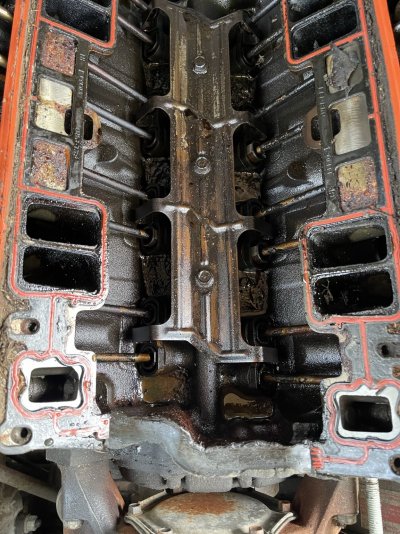Trig
Newbie
Looking for some advice as to next steps on this thing - don't want to do something out of haste that I'll regret later.
Truck has been sitting for probably 3 years now after a front end rebuild went south after a shop mangled my LCA's replacing the bushings. Soured me on the project so it sat longer than it should have. When I finally got it back together I was careful to follow advice found here in various threads surrounding fluid changes and the usual suspects. I also removed all the plugs and squirted fresh oil in all the cylinders followed by hand cranking the engine prior to starting it up. Started up fine, maybe a little hesitation/rough running. I pulled codes and found some misfires (couple of cylinders and the various misfire code I believe). I didn't think much of it considering it hadn't ran for a minute so I cleared and started again and let it run for 30-45 minutes to come up to temp and then pulled codes again and there was nothing confirmed nor pending. Awesome.
Started a DIY alignment to get it close enough to drive to a shop, so it sat for about a week I guess. Tried to start and just a umphh sound like it wasn't getting enough amps. Troubleshooted all that mess and found corroded connections everywhere, along with an oil soaked starter that I replaced. Started up good. Sweet.
Go to back it out of the driveway, and find the brakes going to the floor. Think well it probably needs some fluid so I top it off and it goes to the floor again. F***. Get out, look underneath and see the puddle under the rear end. Replace all the brake lines with the 90-10 CuNi. Good deal.
So, it's probably been 3-4 weeks at this point since starting it last. At some point during this time I pop the radiator cap just because and find it an inch or so low - barely covering the tubing inside. I top it off and figure no biggie it's just air working it self out or whatever. Open it again a week later maybe and same thing, again I top off. Now, I somewhat remember this being an issue going back a ways but I never put two and two together as it's always held proper temperature and the coolant/oil has always looked normal. To this day that holds true.
Fast forward to this week, I'm at it again only to find it won't crank again. Starter makes a god awful noise when I hit it and I immediately stop. Give the motor a look see and try again same thing. I figure maybe it needs shimmed so I drop the starter and look at the flexplate and notice teeth marks but no broken teeth. I add a 0.030 thrust washer to the outboard bolt as that's all I had that was precision and in the ballpark and try again and get the familiar "umpphh". Solenoid pops but can't turn over.
I check the battery connections as the side posts are suspect on mine and find I can move the positives around a bit. I already stripped back the insulation from those as well as the battery terminals as they were in the way. Effed design but whatever. I took some 3/8 ss bolts I had and cut the heads off and bottomed out the studs, locked with a nut and then attached the leads with another nut. Very solid now. Btw, battery checked out fine during the diagnosis earlier.
So, before hitting the key I figure I'll try and hand crank to make sure. It moves but then gets really tight and won't move anymore. I figure compression as I didn't take the plugs out. Remove all the plugs and when I get to the #1 cylinder coolant starts pouring out when I remove the plug. 1/4 -1/2 cup? S***. Likely why it wouldn't crank - coolant hydrolock I believe I've seen but mainly by fuel from the threads I found.
I took a break, googled a bit and don't find a whole lot except probable head gasket. I hand cranked it again and it rotates fine - I noticed a few more TB of fluid came out when I did this. Rotated another revolution and no more fluid. Radiator level is again back to barely covering the tubes and holding.
Looked around the engine bay and noticed coolant sitting in the spot underneath the upper cooling connection where the thermostat is. Hard to see in there but it was wet and shiny like coolant I believe. I believe that is where the intake manifold interface is as to the right of the thermostat housing I can see a big wad of goop where the interface is like RTV excess maybe. I had the intake manifold gasket work done by a shop probably 12 years ago/24K miles. That excess looks odd to me but maybe that's how it's done I'm not sure.
She's never overheated and I've never noticed fluid on the ground or steam from the engine bay or tailpipe. Again, that was prior to it sitting for 3 years and since then I've described above.
Any thoughts/suggestions on where I go from here would be greatly appreciated. From what I gather compression testing is the next step, I'm mainly curious as to what's possible with the intake manifold issue and the coolant levels always dropping down to right above the tubing, which could have been going on for much longer than I think. Or maybe that's simply not possible and/or a separate unrelated issue and I should ignore those pieces of information for now.
Sorry for the lengthy post - last thing I want to do is waste people's time with incomplete information. Let me know if anything else is needed and I'll respond asap.
Regards,
Chad
Truck has been sitting for probably 3 years now after a front end rebuild went south after a shop mangled my LCA's replacing the bushings. Soured me on the project so it sat longer than it should have. When I finally got it back together I was careful to follow advice found here in various threads surrounding fluid changes and the usual suspects. I also removed all the plugs and squirted fresh oil in all the cylinders followed by hand cranking the engine prior to starting it up. Started up fine, maybe a little hesitation/rough running. I pulled codes and found some misfires (couple of cylinders and the various misfire code I believe). I didn't think much of it considering it hadn't ran for a minute so I cleared and started again and let it run for 30-45 minutes to come up to temp and then pulled codes again and there was nothing confirmed nor pending. Awesome.
Started a DIY alignment to get it close enough to drive to a shop, so it sat for about a week I guess. Tried to start and just a umphh sound like it wasn't getting enough amps. Troubleshooted all that mess and found corroded connections everywhere, along with an oil soaked starter that I replaced. Started up good. Sweet.
Go to back it out of the driveway, and find the brakes going to the floor. Think well it probably needs some fluid so I top it off and it goes to the floor again. F***. Get out, look underneath and see the puddle under the rear end. Replace all the brake lines with the 90-10 CuNi. Good deal.
So, it's probably been 3-4 weeks at this point since starting it last. At some point during this time I pop the radiator cap just because and find it an inch or so low - barely covering the tubing inside. I top it off and figure no biggie it's just air working it self out or whatever. Open it again a week later maybe and same thing, again I top off. Now, I somewhat remember this being an issue going back a ways but I never put two and two together as it's always held proper temperature and the coolant/oil has always looked normal. To this day that holds true.
Fast forward to this week, I'm at it again only to find it won't crank again. Starter makes a god awful noise when I hit it and I immediately stop. Give the motor a look see and try again same thing. I figure maybe it needs shimmed so I drop the starter and look at the flexplate and notice teeth marks but no broken teeth. I add a 0.030 thrust washer to the outboard bolt as that's all I had that was precision and in the ballpark and try again and get the familiar "umpphh". Solenoid pops but can't turn over.
I check the battery connections as the side posts are suspect on mine and find I can move the positives around a bit. I already stripped back the insulation from those as well as the battery terminals as they were in the way. Effed design but whatever. I took some 3/8 ss bolts I had and cut the heads off and bottomed out the studs, locked with a nut and then attached the leads with another nut. Very solid now. Btw, battery checked out fine during the diagnosis earlier.
So, before hitting the key I figure I'll try and hand crank to make sure. It moves but then gets really tight and won't move anymore. I figure compression as I didn't take the plugs out. Remove all the plugs and when I get to the #1 cylinder coolant starts pouring out when I remove the plug. 1/4 -1/2 cup? S***. Likely why it wouldn't crank - coolant hydrolock I believe I've seen but mainly by fuel from the threads I found.
I took a break, googled a bit and don't find a whole lot except probable head gasket. I hand cranked it again and it rotates fine - I noticed a few more TB of fluid came out when I did this. Rotated another revolution and no more fluid. Radiator level is again back to barely covering the tubes and holding.
Looked around the engine bay and noticed coolant sitting in the spot underneath the upper cooling connection where the thermostat is. Hard to see in there but it was wet and shiny like coolant I believe. I believe that is where the intake manifold interface is as to the right of the thermostat housing I can see a big wad of goop where the interface is like RTV excess maybe. I had the intake manifold gasket work done by a shop probably 12 years ago/24K miles. That excess looks odd to me but maybe that's how it's done I'm not sure.
She's never overheated and I've never noticed fluid on the ground or steam from the engine bay or tailpipe. Again, that was prior to it sitting for 3 years and since then I've described above.
Any thoughts/suggestions on where I go from here would be greatly appreciated. From what I gather compression testing is the next step, I'm mainly curious as to what's possible with the intake manifold issue and the coolant levels always dropping down to right above the tubing, which could have been going on for much longer than I think. Or maybe that's simply not possible and/or a separate unrelated issue and I should ignore those pieces of information for now.
Sorry for the lengthy post - last thing I want to do is waste people's time with incomplete information. Let me know if anything else is needed and I'll respond asap.
Regards,
Chad



